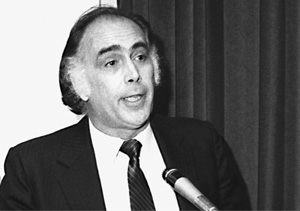by Jesse Hamlin
SF State Magazine looks back at the tenure of a former dean who encouraged big dreams for the future of creative arts at SF State.

He was a scholar and a showman, a big man with big ideas who had the moxie and flair to make things happen. August Coppola, the flamboyant dean of SF State’s College of Creative Arts from 1984 to 1992 who died last year at 75, left a major mark on the University and the arts community he championed.
Coppola, an imposing figure with flowing dark hair, silver sideburns and a taste for tailored suits and hand made scarves, was the driving force behind SF State’s Fine Arts Building, which opened in 1993. With help from powerful friends in the entertainment business and politics, the voluble dean had persuaded the state legislature to provide $15 million for the project at a time of severe budget cutbacks.
The fivestory addition to the old Arts and Industry building (which was remodeled in the process) is a multidisciplinary center that houses film and sound editing labs, a sound stage, dance and design studios, an art gallery and a 150-seat theater named for Coppola. "August made a huge contribution," says Whitney Chadwick, a retired art history professor who fondly recalls the gleaming brass espresso machine the hospitable dean installed in his conference room (food and drink were de rigueur when you met Coppola). "I don’t think that building project, which has transformed the arts and their public presentation at State, would’ve happened without him. August had a tremendous commitment to the arts, and a belief in creative practice way beyond the usual lip service people give it.
"He brought a lot of public attention to the arts at San Francisco State. He saw the arts as something that happened not just in the academy, but in the world. And he was very conscious of making those connections." A novelist, literature professor and sculptor who created the beloved Tactile Dome at San Francisco’s Exploratorium, Coppola inspired many people, among them his younger brother, director Francis Ford Coppola, and his son, actor Nicolas Cage. Both Cage and his uncle Francis were on hand in 1986 when August put on a starstudded event called the Purple Globe Awards, the first of several offbeat and attention-grabbing Coppola productions that raised the school’s public profile. Billed as "an evening of cultural celebration," it was a weird and wonderful shindig featuring celebrities like Angelica Huston, Tom Waits, Gina Lollobrigida, Alice Walker and Danny Glover (attended ’67-’72), rubbing shoulders with sculpture students, Senegalese drummers and a Sicilian string band. "My dad was someone who was always interested in stimulating young imaginations. He did that with me, just as he did with his students," says Cage, on the phone from Louisiana, where he was shooting the movie "Trespass." "As a child, he really tried to get me to be a free thinker, exposing me to great artists and filmmakers. I was probably the only 5-year-old child in the neighborhood who was watching ‘The Cabinet of Dr. Caligari’ and Fellini’s ‘Juliet of the Spirits.’"
In 1991, Coppola made another big splash with a "sky breaking" for the new building. It was his take on the traditional and less entertaining groundbreaking. Actors Annette Bening (B.A., ’80), B.D. Wong (attended ’78–’80) and other notable alumni were among the building’s "godparents" who ceremoniously tossed "magic" beans— either lima or pinto—into a hole in the ground where the dean placed a glass model of the building. Chablis and Cabernet were poured on top. "We’ll see how our dreams grow," Coppola said. The idea of the sky break ing, he added, "is to look up, rather than down—look up to the sky, the clouds, teach young people to dream." You never knew what to expect from Coppola, who established the Audio Vision Workshop with Professor Gregory Frazier, who had created a system for describing movie scenes to blind people. "August was a visionary," says Theatre Arts Professor Larry Eilenberg. "He worked very hard to get people to cross disciplinary lines. He really promoted the notion of interdisciplinary art. Now the culture insists on it. He was ahead of his time."
Eilenberg and Chadwick both cherish the memory of Coppola’s first meeting with the College of Creative Art faculty, in Knuth Hall in 1984. Before saying a word, he blasted an Italian aria. "We were waiting for our new dean to give his inaugural address, and instead he put on a record," Eilenberg says. "We all listened. He started not with deaning, but with art. He had a great passion for it. In some way, he was an operatic figure."